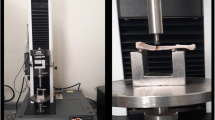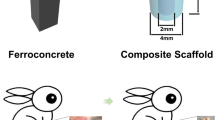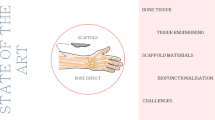Abstract
Researchers have investigated several therapeutic approaches to treat non-union fractures. Among these, bioactive glasses and glass ceramics have been widely used as grafts. This class of biomaterial has the ability to integrate with living bone. Nevertheless, bioglass and bioactive materials have been used mainly as powder and blocks, compromising the filling of irregular bone defects. Considering this matter, our research group has developed a new bioactive glass composition that can originate malleable fibers, which can offer a more suitable material to be used as bone graft substitutes. Thus, the aim of this study was to assess the morphological structure (via scanning electron microscope) of these fibers upon incubation in phosphate buffered saline (PBS) after 1, 7 and 14 days and, also, evaluate the in vivo tissue response to the new biomaterial using implantation in rat tibial defects. The histopathological, immunohistochemistry and biomechanical analyzes after 15, 30 and 60 days of implantation were performed to investigate the effects of the material on bone repair. The PBS incubation indicated that the fibers of the glassy scaffold degraded over time. The histological analysis revealed a progressive degradation of the material with increasing implantation time and also its substitution by granulation tissue and woven bone. Histomorphometry showed a higher amount of newly formed bone area in the control group (CG) compared to the biomaterial group (BG) 15 days post-surgery. After 30 and 60 days, CG and BG showed a similar amount of newly formed bone. The novel biomaterial enhanced the expression of RUNX-2 and RANK-L, and also improved the mechanical properties of the tibial callus at day 15 after surgery. These results indicated a promising use of the new biomaterial for bone engineering. However, further long-term studies should be carried out to provide additional information concerning the material degradation in the later stages and the bone regeneration induced by the fibrous material.









Similar content being viewed by others
References
Virk MS, Alaee F, Tang H, Ominsky MS, Ke HZ, Lieberman JR. Systemic administration of sclerostin antibody enhances bone repair in a critical-sized femoral defect in a rat model. J Bone Joint Surg Am. 2013;95(8):694–701. doi:10.2106/JBJS.L.00285.
Axelrad TW, Kakar S, Einhorn TA. New technologies for the enhancement of skeletal repair. Injury. 2007;38(Suppl 1):S49–62. doi:10.1016/j.injury.2007.02.010.
Valimaki VV, Moritz N, Yrjans JJ, Dalstra M, Aro HT. Peripheral quantitative computed tomography in evaluation of bioactive glass incorporation with bone. Biomaterials. 2005;26(33):6693–703. doi:10.1016/j.biomaterials.2005.04.033.
Drosse I, Volkmer E, Capanna R, De Biase P, Mutschler W, Schieker M. Tissue engineering for bone defect healing: an update on a multi-component approach. Injury. 2008;39(Suppl 2):S9–20. doi:10.1016/S0020-1383(08)70011-1.
Giannoudis PV, Dinopoulos H, Tsiridis E. Bone substitutes: an update. Injury. 2005;36(Suppl 3):S20–7. doi:10.1016/j.injury.2005.07.029.
Dias AG, Lopes MA, Santos JD, Afonso A, Tsuru K, Osaka A, et al. In vivo performance of biodegradable calcium phosphate glass ceramics using the rabbit model: histological and SEM observation. J Biomater Appl. 2006;20(3):253–66. doi:10.1177/0885328206052466.
Dorozhkin S, Ajaal T. Toughening of porous bioceramic scaffolds by bioresorbable polymeric coatings. Proc Inst Mech Eng H. 2009;223(4):459–70.
Hutmacher DW, Schantz JT, Lam CX, Tan KC, Lim TC. State of the art and future directions of scaffold-based bone engineering from a biomaterials perspective. J Tissue Eng Regen Med. 2007;1(4):245–60. doi:10.1002/term.24.
Hench LL, Xynos ID, Edgar AJ, Buterry LDK, Polak JM, Zhong J-P, et al. Gene activating glasses. J Inorg Mater. 2002;17(5):897–909.
Hench LL, Polak JM. Third-generation biomedical materials. Science. 2002;295(5557):1014–7. doi:10.1126/science.1067404.
Xynos ID, Edgar AJ, Buttery LD, Hench LL, Polak JM. Ionic products of bioactive glass dissolution increase proliferation of human osteoblasts and induce insulin-like growth factor II mRNA expression and protein synthesis. Biochem Biophys Res Commun. 2000;276(2):461–5. doi:10.1006/bbrc.2000.3503.
Hench LL. The story of bioglass. J Mater Sci Mater Med. 2006;17(11):967–78. doi:10.1007/s10856-006-0432-z.
Mastrogiacomo M, Scaglione S, Martinetti R, Dolcini L, Beltrame F, Cancedda R, et al. Role of scaffold internal structure on in vivo bone formation in macroporous calcium phosphate bioceramics. Biomaterials. 2006;27(17):3230–7. doi:10.1016/j.biomaterials.2006.01.031.
Spector M. Biomaterials-based tissue engineering and regenerative medicine solutions to musculoskeletal problems. Swiss Med Wkly. 2006;136(19–20):293–301. doi:10.2006/19/smw-11310.
Wu C, Zhu Y, Chang J, Zhang Y, Xiao Y. Bioactive inorganic-materials/alginate composite microspheres with controllable drug-delivery ability. J Biomed Mater Res B Appl Biomater. 2010;94(1):32–43. doi:10.1002/jbm.b.31621.
Boccaccini AR, Maquet V. Bioresorbable and bioactive polymer/Bioglass® composites with tailored pore structure for tissue engineering applications. Compos Sci Technol. 2003;63(16):2417–29. doi:10.1016/S0266-3538(03)00275-6.
Pascu EI, Stokes J, McGuinness GB. Electrospun composites of PHBV, silk fibroin and nano-hydroxyapatite for bone tissue engineering. Mater Sci Eng C Mater Biol Appl. 2013;33(8):4905–16. doi:10.1016/j.msec.2013.08.012.
Poologasundarampillai G, Wang D, Li S, Nakamura J, Bradley R, Lee PD, et al. Cotton-wool-like bioactive glasses for bone regeneration. Acta Biomater. 2014;10(8):3733–46. doi:10.1016/j.actbio.2014.05.020.
Lin Y, Brown RF, Jung SB, Day DE. Angiogenic effects of borate glass microfibers in a rodent model. J Biomed Mater Res A. 2014;102(12):4491–9. doi:10.1002/jbm.a.35120.
Souza MT, Zanotto ED, Peitl-Filho O. Vitreous composition, bioactive glassy fibers and tissues. Patent Application No. BR 10 2013 020961 9. Universidade Federal de São Carlos, Brazil, 2013.
Oliveira P, Ribeiro DA, Pipi EF, Driusso P, Parizotto NA, Renno AC. Low level laser therapy does not modulate the outcomes of a highly bioactive glass-ceramic (Biosilicate) on bone consolidation in rats. J Mater Sci Mater Med. 2010;21(4):1379–84. doi:10.1007/s10856-009-3945-4.
Bossini PS, Renno AC, Ribeiro DA, Fangel R, Peitl O, Zanotto ED, et al. Biosilicate(R) and low-level laser therapy improve bone repair in osteoporotic rats. J Tissue Eng Regen Med. 2011;5(3):229–37. doi:10.1002/term.309.
Pedrosa WF Jr, Okamoto R, Faria PE, Arnez MF, Xavier SP, Salata LA. Immunohistochemical, tomographic and histological study on onlay bone graft remodeling. Part II: calvarial bone. Clin Oral Implants Res. 2009;20(11):1254–64. doi:10.1111/j.1600-0501.2009.01747.x.
Matsumoto MA, Caviquioli G, Biguetti CC, Holgado LA, Saraiva PP, Renno ACM, Kawakami RY. A novel bioactive vitroceramic presents similar biological responses as autogenous bone grafts. J Mater Sci Mater Med. 2012;23(6):1447–56. doi:10.1007/s10856-012-4612-8.
Abiraman S, Varma HK, Kumari TV, Umashankar PR, John A. Preliminary in vitro and in vivo characterizations of a sol–gel derived bioactive glass–ceramic system. Bull Mater Sci. 2002;25(5):419–29.
Schepers EJ, Ducheyne P. Bioactive glass particles of narrow size range for the treatment of oral bone defects: a 1-24 month experiment with several materials and particle sizes and size ranges. J Oral Rehabil. 1997;24(3):171–81.
Ruhe PQ, Boerman OC, Russel FG, Mikos AG, Spauwen PH, Jansen JA. In vivo release of rhBMP-2 loaded porous calcium phosphate cement pretreated with albumin. J Mater Sci Mater Med. 2006;17(10):919–27. doi:10.1007/s10856-006-0181-z.
Qi X, Ye J, Wang Y. Improved injectability and in vitro degradation of a calcium phosphate cement containing poly(lactide-co-glycolide) microspheres. Acta Biomater. 2008;4(6):1837–45. doi:10.1016/j.actbio.2008.05.009.
Gu Y, Chen L, Yang HL, Luo ZP, Tang TS. Evaluation of an injectable silk fibroin enhanced calcium phosphate cement loaded with human recombinant bone morphogenetic protein-2 in ovine lumbar interbody fusion. J Biomed Mater Res A. 2011;97(2):177–85. doi:10.1002/jbm.a.33018.
van de Watering FC, van den Beucken JJ, Walboomers XF, Jansen JA. Calcium phosphate/poly(d, l-lactic-co-glycolic acid) composite bone substitute materials: evaluation of temporal degradation and bone ingrowth in a rat critical-sized cranial defect. Clin Oral Implants Res. 2012;23(2):151–9. doi:10.1111/j.1600-0501.2011.02218.x.
Hench LL, Xynos ID, Polak JM. Bioactive glasses for in situ tissue regeneration. J Biomater Sci Polym Ed. 2004;15(4):543–62.
Valimaki VV, Aro HT. Molecular basis for action of bioactive glasses as bone graft substitute. Scand J Surg. 2006;95(2):95–102.
Moura J, Teixeira LN, Ravagnani C, Peitl O, Zanotto ED, Beloti MM, et al. In vitro osteogenesis on a highly bioactive glass-ceramic (Biosilicate). J Biomed Mater Res A. 2007;82(3):545–57. doi:10.1002/jbm.a.31165.
Renno AC, van de Watering FC, Nejadnik MR, Crovace MC, Zanotto ED, Wolke JG, et al. Incorporation of bioactive glass in calcium phosphate cement: an evaluation. Acta Biomater. 2013;9(3):5728–39. doi:10.1016/j.actbio.2012.11.009.
Zhang XS, Zhang X, Schwarz EM, Young DA, Puzas JE, Rosier RN, O’keefe RJ. Cyclooxygenase-2 regulates mesenchymal cell differentiation into the osteoblast lineage and is critically involved in bone repair. J Clin Invest. 2002;109(11):1405–15. doi:10.1172/JCI15681.
Afzal F, Polak J, Buttery L. Endothelial nitric oxide synthase in the control of osteoblastic mineralizing activity and bone integrity. J Pathol. 2004;202(4):503–10. doi:10.1002/path.1536.
Lemaire V, Tobin FL, Greller LD, Cho CR, Suva LJ. Modeling the interactions between osteoblast and osteoclast activities in bone remodeling. J Theor Biol. 2004;229(3):293–309. doi:10.1016/j.jtbi.2004.03.023.
Kearns AE, Khosla S, Kostenuik PJ. Receptor activator of nuclear factor kappaB ligand and osteoprotegerin regulation of bone remodeling in health and disease. Endocr Rev. 2008;29(2):155–92. doi:10.1210/er.2007-0014.
Anandarajah AP. Role of RANKL in bone diseases. Trends Endocrinol Metab. 2009;20(2):88–94. doi:10.1016/j.tem.2008.10.007.
Pinto KN, Tim CR, Crovace MC, Matsumoto MA, Parizotto NA, Zanotto ED, et al. Effects of biosilicate((R)) scaffolds and low-level laser therapy on the process of bone healing. Photomed Laser Surg. 2013;31(6):252–60. doi:10.1089/pho.2012.3435.
Kondo N, Ogose A, Tokunaga K, Ito T, Arai K, Kudo N, et al. Bone formation and resorption of highly purified beta-tricalcium phosphate in the rat femoral condyle. Biomaterials. 2005;26(28):5600–8. doi:10.1016/j.biomaterials.2005.02.026.
Saino E, Grandi S, Quartarone E, Maliardi V, Galli D, Bloise N, et al. In vitro calcified matrix deposition by human osteoblasts onto a zinc-containing bioactive glass. Eur Cell Mater. 2011;21:59–72 discussion.
Valerio P, Pereira MM, Goes AM, Leite MF. The effect of ionic products from bioactive glass dissolution on osteoblast proliferation and collagen production. Biomaterials. 2004;25(15):2941–8. doi:10.1016/j.biomaterials.2003.09.086.
Granito RN, Ribeiro DA, Renno AC, Ravagnani C, Bossini PS, Peitl-Filho O, et al. Effects of biosilicate and bioglass 45S5 on tibial bone consolidation on rats: a biomechanical and a histological study. J Mater Sci Mater Med. 2009;20(12):2521–6. doi:10.1007/s10856-009-3824-z.
Bosch C, Melsen B, Vargervik K. Importance of the critical-size bone defect in testing bone-regenerating materials. J Craniofac Surg. 1998;9(4):310–6.
Acknowledgments
The authors are indebted to CAPES, CNPq and FAPESP, São Paulo Research Funding Agency, Grant Number 2013/07793-6 (CeRTEV - Center for Technology, Research and Education in Glass) for funding this research work and PhD students Grant 2011/22937-9.
Author information
Authors and Affiliations
Corresponding author
Rights and permissions
About this article
Cite this article
Gabbai-Armelin, P.R., Souza, M.T., Kido, H.W. et al. Effect of a new bioactive fibrous glassy scaffold on bone repair. J Mater Sci: Mater Med 26, 177 (2015). https://doi.org/10.1007/s10856-015-5516-1
Received:
Accepted:
Published:
DOI: https://doi.org/10.1007/s10856-015-5516-1




